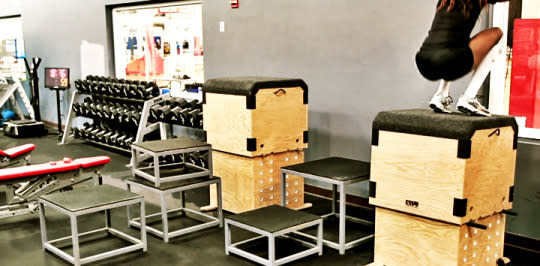The Workout You Need to Do If You Want to Boost Power and Speed

Want to improve your vertical jump? How about your speed and agility? Add plyometric drills to your strength and conditioning program to quickly increase your explosive power.
How Plyometrics Work
Lifting heavy weights won’t help you much on the field or court if you can’t lift them fast. A 400-pound Squat won’t help you jump any higher than someone who can only squat 200 pounds. You’ll run faster and jump higher if you’re able to put more force into the ground quicker.
Plyometric exercises enable muscles to reach maximum force in the shortest possible time, using something called the stretch-shortening cycle (SSC). The exercises increase the power of subsequent movements by using both the natural elastic components of muscle and tendon, and the stretch reflex.
The exercises must be quick and powerful movements that follow the pattern below:
• Eccentric phase: preloads (stretches) the muscle, as when squatting before a jump
• Amortization (transition) phase: pause between the eccentric and concentric phases, as when transitioning from squat to jump
• Concentric phase: muscle contracts to produce explosive movement, as when jumping
Types of Plyos
Lower-body plyometrics are appropriate for virtually any athlete in any sport. These drills usually involve hopping and jumping, and include the following:
• Jumps in Place: Jumping Jacks, Jumping Rope, Squat Jumps and Tuck Jumps
• Jumps Over Barriers: Hurdles, cones, etc.
• Multiple Hops and Jumps: Rapidly repeating jumps or hops
• Bounds: Bounding, Lateral Bounding, Broad Jumps
• Box Drills: Box Jumps, Lateral Box Jumps, Single-Leg Box Jumps
• Depth Jumps: Stepping off box and jumping immediately for distance or height (advanced)
Here’s an example of a Static Box Jump
Exercise Instructions: Position a box between 6-24 inches off the ground based on jumping ability. Standing with box about one foot in front of you position feet roughly hip width apart. Squat down until thighs are parallel to the ground and then stop in that position. Explosively jump out of that position and onto the box in front of you. Step off the box and repeat for repetitions or time.
Plyometric drills for the upper body are not performed as often as those for the lower body, but they should not be ignored. The upper body needs to be explosive for throwing, swinging and pushing.
• Push-Ups: Plyo Push-Ups, Clap Push-Up, Lateral Plyo Push-Ups
• Med Ball Drills: Explosive Med Ball Throws, Med Ball Partner Tosses
Here’s an example of a Medicine Ball Overhead Pass with a Partner
Exercise Instructions: Stand with your feet shoulder-width apart and hold a medicine ball in both hands over your head. Take a step forward and throw the ball towards your partner. Catch the ball with two hands at chest level and repeat motion for repetitions or time.
Plyometric Workout Design
Plyo exercises place great stress on muscles, tendons and joints; and too much plyo work can cause injury or inhibit performance. Therefore, it’s important to carefully plan your plyo workouts and listen to your body.
Plyometric training sessions can be performed one to three times per week, depending on your sport and the time of year. Base the workouts on the following guidelines:
• Volume: Beginners, 50-60 reps total / Advanced, 100-120 reps total
• Recovery: 5-10 seconds for every second of work to allow for full recovery
• Warm-Up: Perform a full dynamic warm-up before every plyo workout to prevent injury
Safety Considerations
• Perform plyos only after building an adequate base of strength, speed, and balance
• Start with simple plyo exercises and progress to more advanced versions
• The landing surface must be flat and shock-absorbant; grass fields, rubber mats and padded plyo boxes are all good choices
• Wear supportive, non-slip footwear
• Always perform plyos in the presence of a qualified strength coach
Source
1 Jared W. Coburn and Moh H. Malek, Eds., NSCA’s Essentials of Personal Training. 2nd. Ed., 2011.
2 Brian Lebo, owner and director of Athletic Performance Training Center and a National Strength and Conditioning Association (NSCA) Certified Strength and Conditioning Specialist (CSCS).
If you are looking for a new way to fitness train check out the free GPW Training App by Go Pro Workouts. You can access custom workouts, access thousands of exercise videos and personally track all your results! Get started here
